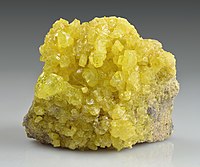
Photo from wikipedia
The removal of toxic hydrogen sulfide (H2S) from the air at pilot-scale with elemental sulfur recovery was evaluated using Fe-EDTA chelate as a single treatment at a pH of about… Click to show full abstract
The removal of toxic hydrogen sulfide (H2S) from the air at pilot-scale with elemental sulfur recovery was evaluated using Fe-EDTA chelate as a single treatment at a pH of about 8.5. This was later combined with a compost biofiltration process for polishing the pre-treated air. Experiments were performed in a unique container system that allowed deploying either Fe-EDTA chelate or Fe-EDTA chelate/biofiltration treatment (hybrid system). The results showed the feasibility of H2S removal at concentrations between 200 and 5300 ppmv (H2S loading rates of 7-190 g m-3 h-1) present in fouled air. The Fe-EDTA chelate as a single treatment was able to remove nearly 99.99% of the H2S at inlet concentrations ≤ 2400 ppmv (107 g m-3 h-1), while the hybrid system archived undetectable outlet H2S concentrations (<1 ppmv) at inlet levels of 4000 and 5300 ppmv. At 5300 ppmv, the Fe-EDTA chelate process H2S removal efficiency decreased to 99.20% due to the limitation of oxygen mass transfer in the Fe(III) regeneration reaction. Under the previous conditions, the pH was required to be controlled by the addition of NaOH, due to the likely occurrence of undesirable parallel reactions. The elemental sulfur yield attained in the physicochemical module was 75-93% with around 80% recovered efficiently as a solid.
Journal Title: Chemosphere
Year Published: 2019
Link to full text (if available)
Share on Social Media: Sign Up to like & get
recommendations!